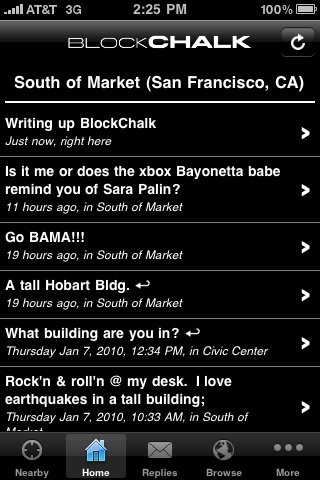 With its new geolocation API, Twitter has the potential to delve into the realm of messages that are relevant based on location. But right now, most geotagged tweets are simply regular tweets that are being tagged with location, and really don’t have much specifically to do with it. Enter BlockChalk, a new service built around the idea of leaving simple messages directly tied to a specific location.
With its new geolocation API, Twitter has the potential to delve into the realm of messages that are relevant based on location. But right now, most geotagged tweets are simply regular tweets that are being tagged with location, and really don’t have much specifically to do with it. Enter BlockChalk, a new service built around the idea of leaving simple messages directly tied to a specific location.
The service, created by Stephen Hood, the former product team lead for Delicious, and Dave Baggeroer of Stanford’s Institute of Design, works because they keep it simple. You load up the application on your mobile device, it locates you, and you leave a message. This can be whatever you want: A note about a good cafe, a tip of something in the neighborhood to watch out for, a request to borrow something that someone else may have in the neighborhood, etc. When other people also using the app come upon the area that you’ve pinned your “Chalk” (their word for message) to, they’ll see it on their screen in a stream of Chalks.
And you can do a bit more with these Chalks. With the service’s new iPhone app, if you use the syntax “[here],” BlockChalk will put in your exact location. You can also attach a link to a location on a map by inserting an actual address in those same brackets. If you don’t do either of these, BlockChalk will hide your exact location, and keep your message pinned to the general area instead.
Once you drill down to a specific Chalk, you can choose to “Chalkback” (respond publicly to a message), “Reply Privately” (respond just to the user who left the Chalk), “Bury,” or “Share,” the chalk.
While I noted the service’s new iPhone app (which you can find in the App Store here as a free download), it’s already available on a number of other platforms thanks to some more advanced web technology. For example, you can use it on Android phones (or the mobile web of the iPhone, for that matter) because the web-based version of BlockChalk uses HTML5 to access location through the browser, Hood tells us. Obviously, that’s a vital part of the app. There is also a webOS BlockChalk app already that will work on the Palm Pre or Pixi. Hood notes that they are currently working on native apps for Android and BlackBerry as we speak.
Thanks to this mobile web usage, BlockChalk is already available in some 93 countries, 6751 cities and 10910 neighborhoods. And while the obvious integration with Twitter’s new location feature is pretty loose right now, Hood tells us that in the next release, it will be much tighter.
The company is in the process of raising a seed round of funding. And while obviously they’ve declined to say how much they’re looking to raise, we hear Hood’s old Delicious counterpart Joshua Schachter is interested. That shouldn’t be surprising given his recent location-based investments.
Learn more in the video below: